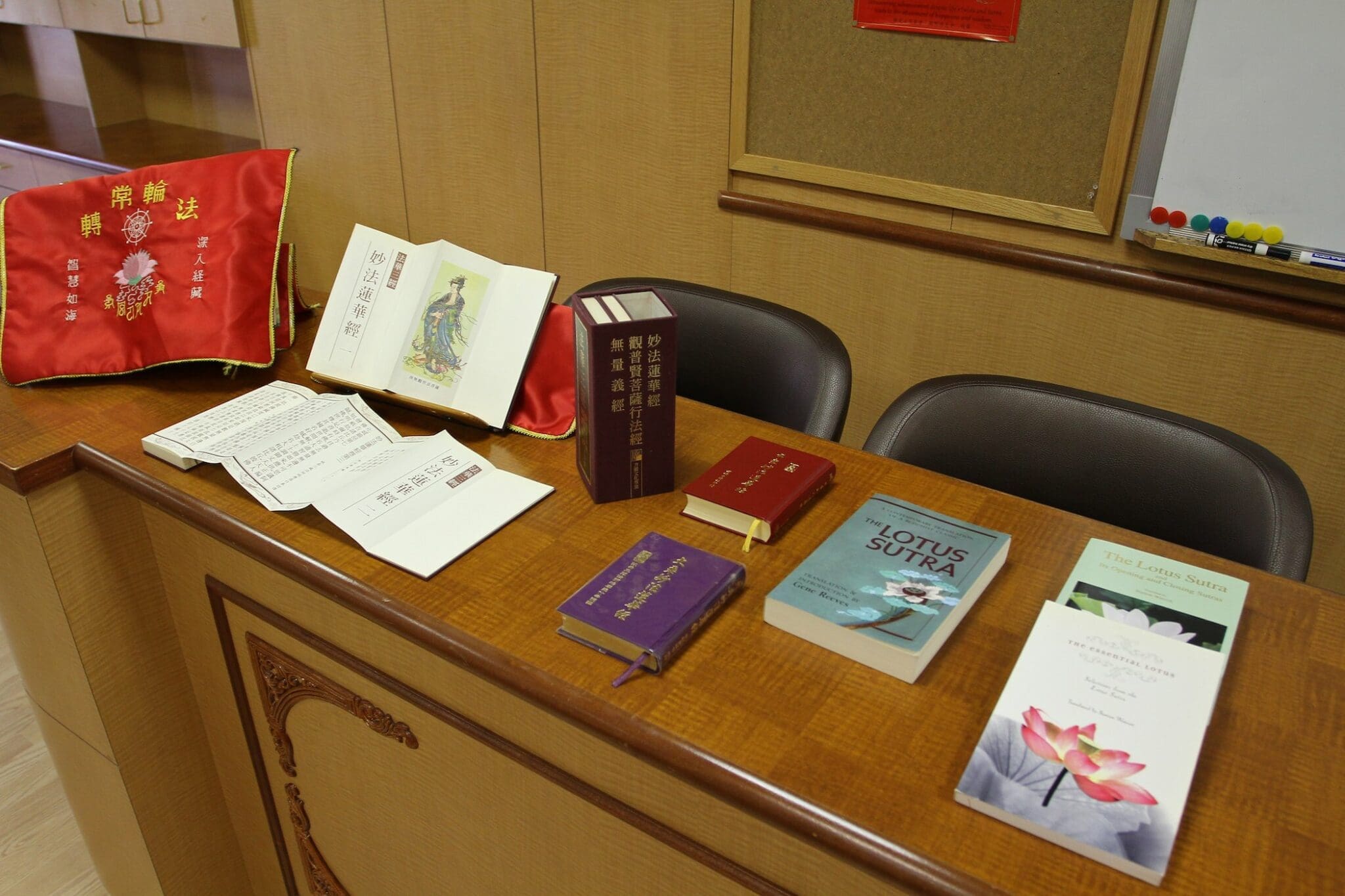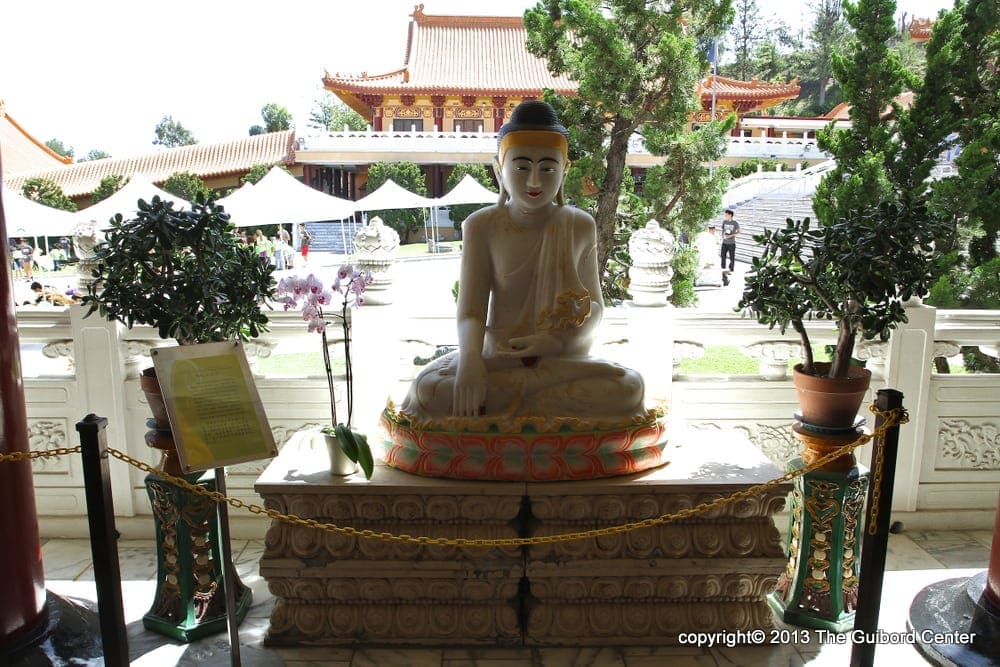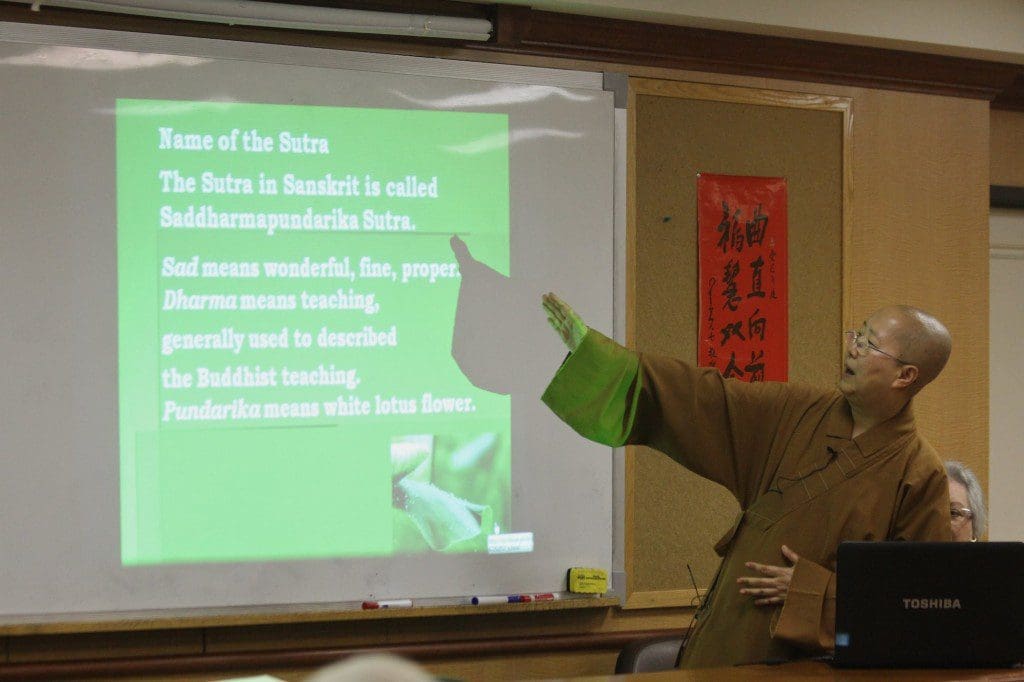











Part 2: The Teaching on The Lotus Sutra
Venerable Miao Hsi leads us back to our classroom where she has laid out a colorful display of various versions of the Lotus Sutra. We are invited to look through these, to handle them, to become friends. She has gathered these especially for us – carefully, deliberately, thoughtfully. Here we find not only the Temple’s copy of this sacred text, but Miao Hsi’s own personal copies. She has gone to a fellow sister to borrow a dearly cherished edition.
There is one in particular that is covered and on a stand just as it is on the shrine in her own room. It quickly becomes clear that rather than providing us with a dry, scholarly treatise on Buddhist sacred texts, Venerable Miao Hsi is instead gently introducing us to a beloved source of great wisdom and compassion known and revered throughout the world and precious to her own heart. As we explore and touch these many different volumes, these many different translations, in different sizes and forms and sensibilities, we begin to realize just how broad their appeal is to Buddhists everywhere.
People pour into the courtyard of Hsi Lai Temple every full and new moon to join with the monks and nuns in chanting the Lotus Sutra including the very verses we have just recited in the Main Temple above us. The wooden fish, one of the dharma instruments we heard, keeps up the tempo for them all the way through the reading, just as it did for us moments ago.
The chapter we tried to follow is Chapter 25 (of 28), The Lotus Sutra of the Universal Gate Chapter. Now, as is appropriate upon meeting someone new, we are introduced properly and discover the chapter’s formal name is Avalokitesvara Bodhisattva Universal Gate Chapter. The Lotus Sutra’s proper name in Sanskrit is Saddharmapundarika. It means: The Wonderful Dharma of the Lotus Flower Sutra. Our teacher gently and carefully breaks down the meaning for us, one step after another, and as she does so, the history of Buddhism unfolds before us. This is no secondary scripture that she has selected to share with us…
The Lotus Sutra is said to be the King of Sutras. It “was spoken by the Sakyamuni Buddha … during those eight years before he entered into Nirvana. It is the Buddha’s ultimate teaching. i.e., the final Dharma,.. his final revelation on the universality of liberation, attaining the true nature of Buddhahood, and the best and universally applicable means of attaining Buddhahood.”
It is all here and we will leave with at least a sense of the beauty and magnitude it offers. “We consider the Sutra as the pure, complete, unique, and solitary wonderful teachings in Buddhism.”
We follow its journey through antiquity to today and become acquainted with the courageous Kumarajiva, whose vow as a youth to travel to China and translate the Sutra into Chinese remained intact through a life that included imprisonment and brutality. Remarkably the translation he completed in 406 A.D. is right here on the table in front of us. It is still read today and is the favorite choice of Chinese readers everywhere.
Miao Hsi explains that various schools of Buddhism that all practice and uphold the Sutra came into being depending on which part of these teachings resonated within their own community. The Tian Tai School, highly respected throughout Japan and all of Eastern Asia, built itself around dedication to every aspect of the veneration and study of the Lotus Sutra.
Now that we have a sense of respect for the magnitude of this text, we circle back again to take a closer look at the meaning of its name. We already know that Saddharmapundarika means “The Wonderful Dharma [Teaching] of the Lotus Flower.” Now we go deeper to open up what those words are intended to convey.
Miao Hsi begins by telling us the story of the ancient Chinese master who explained the meaning of the single word “wonderful” [“Miao, the same as my name,” she notes with a smile] in a mere 90 days! The Sutra is filled with analogies and interesting stories of how to attain Buddhahood. The Dharma [Teachings] are vast and complex. The Dharma of The Lotus Flower is the teaching of the Large Vehicle, the Buddha Vehicle, intended with great kindness to carry lots and lots of people to Nirvana. Everyone is invited! Everyone is welcome!
The Lotus Flower, symbolic of the wonderful teaching of the Buddha Vehicle, is an analogy. Each slide in the power point we are being shown has had a picture of a lotus flower. By now we have seen many perspectives: from the angle of the water to the full overview. Miao Hsi draws our attention to these specifically now as she focuses in on the images we have looked at but not yet seen. It is well known that the lotus is an important symbol in Buddhism. We are about to understand why.
“The lotus flower is very hard to grow. It is very dirty. You have its roots there. It comes out with the leaves. Look at the leaves. The lotus flower is big and so beautiful and of course there are different colors and it is fragrant and it is so pure but it grows out of very dirty water. It is symbolic of us living in this world, of troubles and worries and defilements, but we can still live a pure life. It is in our minds. If you have a pure mind, you live a pure life.”
The analogy becomes richer as she points out that every part of the lotus (like every experience and every being) is useful, helpful, in its own way: The Chinese make a meal from the roots. The stem is strong and hollow. A straw. A pen. Lotus paste comes from the seeds. The leaves are used for covering one’s head – a hat –a tea also that can cure heat stroke.
“It is the only flower that has the roots, the stem, the flower and the pod all at the same time.” And “The whole lotus from the roots, to the leaves, to the flowers, to the seeds – it is all useful. The lotus is truly wonderful.”
The part of the Lotus Flower Sutra that our gentle guide has chosen for us to experience is Chapter 25, Avalokitesvara Bodhisattva Universal Gate Chapter. It is our turn to smile when we learn that Avalokitesvara Bodhisattva is none other than the wildly popular Buddhist and cultural icon Quan Yin. We in the West have come to know “her” as “The Goddess of Mercy” – even though that’s both a distortion and diminishment of this magnificent being. Our understanding will deepen and open once again as we discover what Avalokitesvara Bodhisattva actually represents.
Guan Yin
Avalokitesvara (Guan Yin) Bodhisattva was once an ancient buddha “a long, long time ago beyond our comprehension” who chose to come back as a bodhisattva bearing the quality of compassion. He became so popular that he came to be thought of as a god. The female image that represents his presence led him to become known mistakenly as the Goddess of Mercy.
Venerable Miao Hsi corrects this profoundly misleading misperception. Quan Yin is not a god or a goddess – he is a bodhisattva. He brings not “mercy” but “compassion” – “lovingkindness.” He is not a woman – he is a male being. Miao Hsi is careful to make clear that this is not a denigration of women, for there are many revered women who are enlightened. It is important to the integrity of who Avalokitesvara (Quan Yin) Bodhisattva is. [As she speaks I think of how dangerous it is when we separate men from compassion. No wonder there is such violence in the world. A profound transformation would occur if men were allowed – even encouraged – to recognize compassion as a core part of themselves. LS]
Avalokitesvara means “observing of the sound (of suffering).” Bodhisattva comes from bodhi, meaning “enlightened” or “to enlighten.” And sattva means “a being.” Bodhisattva is interpreted as “this being is enlightened” or “this being wants to enlighten others” so it is both ways. Bodhisattvas, we are told, observe the sounds and sights of suffering and they come to help. They come in many forms.
They come in whatever way we can receive them.
The Universal Gate Chapter recites the many ways that Avalokitesvara (Guan Yin) Bodhisattva (compassion and lovingkindness) changes our lives. “Avalokitesvara Bodhisattva embodies all virtues universally,.. manifests the light of compassion and liberation,.. responds to living beings without exception.” The Seven Kinds of Difficulty that compassion transforms: Fire, Water, Rakshas and Yakshas (demons), Knives and staves, Ghosts, Imprisonment, Thieves and Robbers.
Strange words, until Miao Hsi explains – these are symbolic of inner experiences. What made no sense upstairs now begins to resonate. We have all felt the emotional pain of being “burned” by some event or person, or drowned, or cut, “stabbed in the back,” haunted, held prisoner, robbed. These make painful sense as inner experiences in response to outer events.
We know the Three Poisons: Greed, Anger and Ignorance and how being caught up in them damages our inner well-being, our peace, our presence.
We know the Seven Jewels – The Seven Virtues: humility, kindness, abstinence, chastity, patience, generosity and diligence. We don’t always realize just how much they are to be treasured because they bring us peace.
We are gradually learning about compassion, about lovingkindness, and about what happens when compassion and lovingkindness come willingly and eagerly into our lives,.. about what happens when we turn, against all odds, again and again to call out to the compassion in ourselves.
As we listen, as we imagine, as we try on the possibility, we begin to sense something under all the words, something bigger than the words, something ancient and true.
Sakyamuni Buddha taught “that accepting and upholding Avalokitesvara Bodhisattva’s name can gain the benefit of boundless and countless merit.” Turning to compassion, yearning for compassion, reaching for compassion brings us peace and leads us ever into kindness.
As the lecture with our gentle and lovely teacher comes to an end, we recognize that we have been well nourished by the kindness that she has shown in this time together. We are wonderfully nourished long before we partake in the delicious vegan meal the Temple offers so generously as a gift to those who are taking part in The Guibord Center’s Sacred Texts this day.
Thank you, Venerable Miao Hsi and all who are a part of Hsi Lai Temple for a remarkable experience of The Dharma of the Wonderful Lotus Flower Sutra. You not only taught it, you lived it with us.
